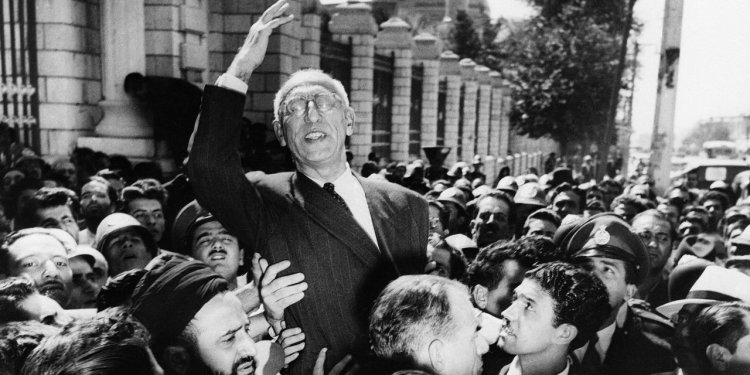The Real Story of the 1953 Iranian Coup
The left blames the CIA for the eventual rise of the ayatollahs. The truth is more complicated. By Ray Takeyh Aug. 18, 2023 5:36 pm ET Prime Minister Mohammed Mossadeq rides on the shoulders of cheering crowds outside the parliament building in Tehran, Sept. 27, 1951. Photo: ASSOCIATED PRESS Saturday is the 70th anniversary of the coup that toppled Iran’s Prime Minister Mohammad Mossadeq. For decades, the left has insisted that President Dwight Eisenhower’s Cold War obsession led him to overthrow a democratically elected leader, paving the way for an Islamist revolution a quarter-century later. The coup, in this telling, was the original sin. After seven decades it’s time to set the record straight. Mossadeq was a Persian aristocrat who objected to Britain’s control of Iran’s oil. He led the


Prime Minister Mohammed Mossadeq rides on the shoulders of cheering crowds outside the parliament building in Tehran, Sept. 27, 1951.
Photo: ASSOCIATED PRESS
Saturday is the 70th anniversary of the coup that toppled Iran’s Prime Minister Mohammad Mossadeq. For decades, the left has insisted that President Dwight Eisenhower’s Cold War obsession led him to overthrow a democratically elected leader, paving the way for an Islamist revolution a quarter-century later. The coup, in this telling, was the original sin.
After seven decades it’s time to set the record straight. Mossadeq was a Persian aristocrat who objected to Britain’s control of Iran’s oil. He led the nationalization charge and was instrumental in Iran’s reclaiming its national asset. He wasn’t democratically elected to his post but appointed by Shah Mohammad Reza Pahlavi. He was stubborn and uncompromising, and he relished defying the great powers.
America became involved with Iran at Mossadeq’s instigation. Once negotiations over oil with Britain deadlocked, Mossadeq implored President Harry S. Truman to mediate the dispute. From 1951 until the eventual coup, a succession of American diplomats came up with numerous plans, all of which Mossadeq rejected. The U.S.-crafted compromise called for Britain to accept the principle of nationalization and for Iran to compensate Britain for the loss of its assets, which included the world’s largest refinery. Although London resented Washington’s evenhandedness, as a junior partner it had no choice but to agree. Diplomacy failed only because of Mossadeq’s obduracy.
To pressure him, Britain imposed an embargo on Iranian oil. Deprived of revenue, Iran’s economy cratered. The less money Mossadeq got, the more despotic he became. He rigged elections, disbanded Parliament, usurped the powers of the monarch, and showed little respect for the constitution.
His ruinous policies and dictatorial tendencies alarmed Persian power brokers. The shah was still too young and hesitant to take charge, but merchants, mullahs and military officers all began plotting against the prime minister. The clerical estate was critical to Mossadeq’s overthrow—something the Islamic Republic denies and Western professors whitewash.
By 1953 Iranians were asking the U.S. Embassy for support. Eisenhower seemed sympathetic because of Mossadeq’s increasing reliance on the Tudeh Communist Party. Eventually the Central Intelligence Agency dispatched Kermit Roosevelt to Iran to work with the horde of scheming Persians.
But the CIA didn’t create the opposition to Mossadeq. Lt. Gen. Fazlollah Zahedi, one of Iran’s most distinguished officers, had already organized the military to overthrow the prime minister, mullahs were using their street muscle to organize demonstrations against Mossadeq, and merchants were closing their bazaars in protest.
All the while the monarchy as an institution still commanded popular support. America’s most essential contribution to Mossadeq’s removal was to get the shah to dismiss his prime minister. The monarch had the constitutional authority to do so but lacked the courage. Finally, on Aug. 15, after much American arm-twisting, Pahlavi fired Mossadeq. All the talk of a coup should note that once the shah issued his decree Mossadeq’s premiership was rendered illegal.
Tipped off by communist cells in the Iranian army, Mossadeq was waiting for the officer who delivered his dismissal orders. The officer was quickly arrested, and the shah fled the country. For Washington, the coup had ended. The State Department acknowledged that the “operation has been tried and failed and we should not participate in any operation against Mossadegh.” The CIA concurred: “Operations against Mossadegh should be discontinued.” Gen. Walter Bedell Smith,
Eisenhower’s aide, told the president that the plan had failed and that “we now have to take a whole new look at the Iranian situation and probably have to snuggle up to Mossadeq if we are going to save anything there.”In Tehran, the Iranians took command of the situation. The mullahs inflamed the streets with their sermons while the military gained control of the capital. Mossadeq went into hiding, only to turn himself in after a few days on the run. A stunned shah planning for a life in exile was summoned back to Iran. No one was more surprised by this turn of events than the spy masters at the CIA.
The 1953 coup is a rare intelligence operation that has penetrated our national narrative. The left laments a coup it doesn’t understand, commemorating it in Hollywood films such as “Argo.” Former Secretary of State Madeleine Albright even remarked that “the coup was clearly a setback for Iran’s political development. And it is easy to see now why many Iranians continue to resent this intervention in their internal affairs.”
For Democrats, the coup’s lessons are clear: America should avoid taking sides in Iranian politics because the results are bound to be bad. Setting the record straight on 1953 is the first step toward a sensible Iran policy.
Mr. Takeyh is a senior fellow at the Council on Foreign Relations.
Journal Editorial Report: The week's best and worst from Kim Strassel, Kate Bachelder Odell, Allysia Finley and Dan Henninger. Image: Scott Morgan/Reuters The Wall Street Journal Interactive Edition
What's Your Reaction?













